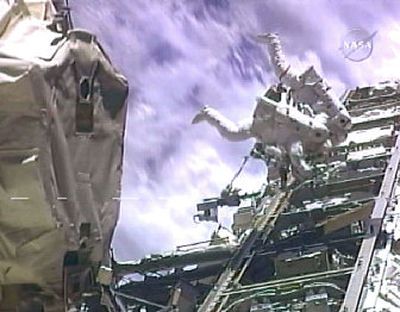Spacewalking astronauts add truss to space station

Discovery astronauts completed the first major task of their mission Tuesday, successfully installing the 2-ton P5 truss on the International Space Station’s main backbone during a six-hour spacewalk.
While veteran Robert Curbeam and rookie spacewalker Christer Fuglesang, of Sweden, directed the maneuver with hand signals, mission specialists Sunita Williams and Joan Higginbotham used the station’s robotic arm to delicately maneuver the $11 million truss into position.
The truss passed within 2 inches of one of the station’s solar arrays – much closer than NASA ordinarily would prefer – but the installation was completed without incident.
The 11-foot truss brings the length of the backbone to 180 feet. It eventually will reach 250 feet when the station is completed.
After bolting the truss into place, Curbeam and Fuglesang connected power, data and heater cable connections to the truss. They also moved a handle that was used to grip the truss and replaced a television camera outside the station.
Earlier in the day, National Aeronautics and Space Administration engineers in Houston told the Discovery crew that they would not have to perform an extended inspection of the shuttle today.
Sensors on the heat tiles on the belly and wing of the craft had detected “very low” impact readings in several areas, but inspection of pictures of the areas showed no significant abnormalities.
The area will be reinspected next week, however, after Discovery undocks from the space station.
The engineers’ decision will allow the astronauts to proceed with their planned activities today, the most important of which is the retraction of the port solar array on the P6 truss to provide room for installation of four new solar panels, two of which already are on site and two of which will be delivered next year.
The 6-year-old solar array must be retracted at least 40 percent to allow the new ones to track the sun properly. If it does not retract properly automatically, the crew might have to make an additional spacewalk to free it.
The two remaining spacewalks, during which the astronauts will rewire the station’s electrical system, will take place Thursday and Saturday.